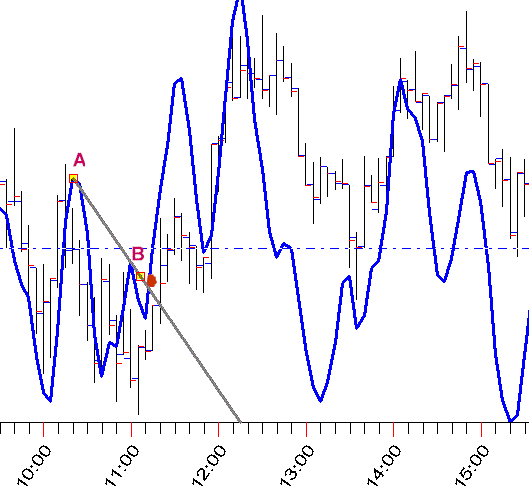
Entering DayTrade Swings
In this article I want to introduce an important concept I'll generically call "the trigger". In trading parlance a trigger is a clear event that has you entering a trade - it is the last step in a trade setup. What precedes the trigger in a trade setup could be something like price pivoting on a support/resistance level, one of the many TS price forecasts, planetary aspect timing, market geometry timing like the 128 technique, etc. In other words, the first part of the trade setup has you anticipating a price swing - the trigger confirms it and gives you an entry price and time.
The examples presented are for daytrading, though the concepts are applicable to higher timeframes. I'll be using the DJ Index for several reasons. As it updates every two seconds, it can be used as a proxy for any of the many DJ index tradeables like the DJ mini futures, DJ full futures, the ETF Diamonds, the DJ single stock-futures, and options on the DJ mini. Why would you want to do this? Because the index has far less "noise" then any of the tradeables. As such it improves whatever method you're using. And of course we all know that the index and the tradeables can never diverge more then a few ticks for when they do they are immediately arbitraged. At $5 a tick, low margin, and trading volume around 200,000 contracts a day the DJ mini futures are great for daytrading.
Last year I asked Sergey to add an indicator to TS called Smooth Momentum (SM). It has several uses, here I'll profile it as an entry trigger. A very important point is that this trigger method will not work well on timeframes under three minutes - as a general rule, the smaller the timeframe, the more market noise.
To create the trigger we connect pivots on the SM indicator - below I drew a trendline connecting pivots A and B. When SM breaks that trendline (see the red dot to the lower right of B) you have an entry trigger to go long. In this example, whether you drew the trendline on price itself or on SM you would have about the same result. But often SM will let you draw trendlines that are not apparent on the price chart and also give you earlier entry before the swing starts, when price often moves so fast its hard to get in.

Below I've placed the SM trendlines for this trading day. Only the green trendline break didn't result in a profitable trade! While this is a crowded screen, you can easily review from left to right and note how the trendlines were drawn on SM. Each red dot represents a trendline break, and a trade entry opportunity. A few of these SM Trendlines you couldn't draw using price alone, like the red, brown or magenta.

Word to the wise: this SM trigger method can be applied to the NYSE advance-decline line.
While on certain days you can "clean up" just using this trigger method, you don't want to use this method by itself. For the DJ Stock index I would recommend you also use the Support Resistance methods outlined in my article titled "Planetary Lines Intraday". You can replace the MACD Histogram with Smooth Momentum, using it the same way as MACD is used in that article. Additionally, you can use an intraday price forecast modeled after Sergey's Spectrum - Neural Net approach, which he published a few months ago. The idea is first see when forecasted trend changes are to occur and then trade then only if you get a SM trendline break. The two together up your odds significantly.
Next I'll preview a few other TS methods that can be used to form an opinion that a trend change or swing is forthcoming, an opinion that is confirmed and traded using SM trendlines.
To anticipate a change in trend you can use the "Time Lines....Planetary Equidistant Lines" drawing tool. Below I've selected "Moon...Moon". I simply connected the high at S1 to the low at S2. The first vertical line to the right of S2 is calculated by TS and it caught the next trend change. The next vertical line out catches the breakout from a triangle chart pattern. Of course you'd have your SM plotted in the main window and trade when the SM trendline is penetrated by SM.
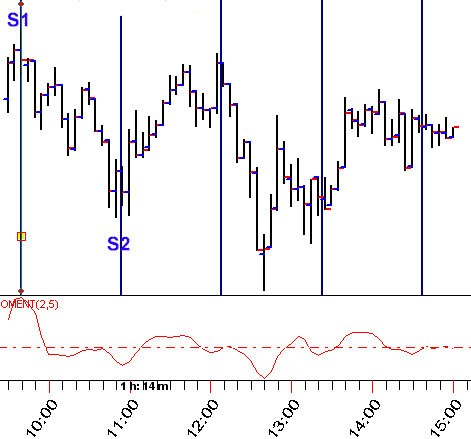
Next I'll preview a slightly more advanced use of "Time Lines....Planetary Equidistant Lines". Below I connected S1 to S2 - but in "regular" use we normally wouldn't use the S2 pivot - we'd use the higher high a few bars to its right. What I do is look at Smooth Momentum (plotted in the sub-chart below). SM shows a higher reading for the pivot at S2 then it does for the higher price a few bars to the right. So I use the higher SM reading for the pivot - this often gives more accurate trend-change overtone lines. The idea is that planetary cycles result in momentum swings, and using the highs and lows of momentum is a more accurate reflection of the planetary cycle then absolute price values.
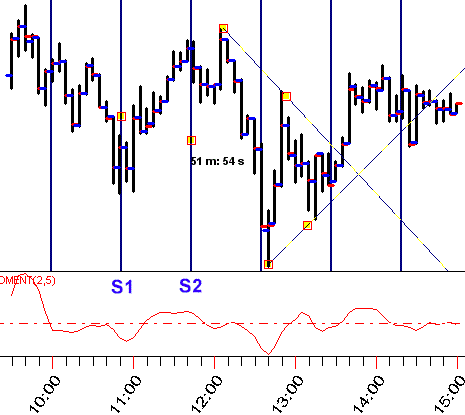
Another good method to use for anticipating a change in trend is the 128 method. This was added to TS by my request and here's a good opportunity to show how its used as most are probably unfamiliar with it. On the below chart you first connect two highs, then the low between them. The dashed red lines are anticipated trend change (or range breakout) times. Well - its usually not this good. To help avoid losing trades you would only take the trade if a SM trendline were broken. So the trend-change prediction shown below is the setup, the SM trendline break is the confirming trigger. Note that you can use the 128 technique spanning several days. Just select "Bar", instead of "Time", in the upper menu. Finally, while I'm showing a High-Low-High sequence below, of course it can be used on Low-High-Low.
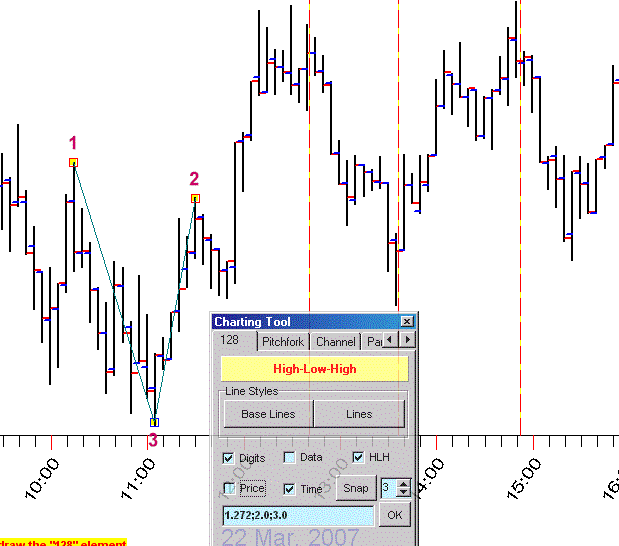
The final setup method I'll present deals with planetary hours. Don't forget that to use them you must select them in the options box PRIOR to clicking "Calculate". We've been using Thursday March 22, 2007 in the above examples. Thursday is the day of Jupiter, so I'm interested in the Planetary Hour of Jupiter, along with Venus. Why Venus? In effect Jupiter and Venus are related, as the major and minor benefic. So on Tuesday, the day of Mars, you'd use Mars and Saturn, the two malefics. Monday would be Sun and Moon, the two Lights. You would create (and save) your ULE query as shown below. I also want to see intraday aspects to Jupiter on Thursday (on Friday, the day of Venus I'd use the same two Planetary Hours and the same aspects, but to Venus instead of Jupiter). Don't forget to modify the Events formula and to click the red checkmark.
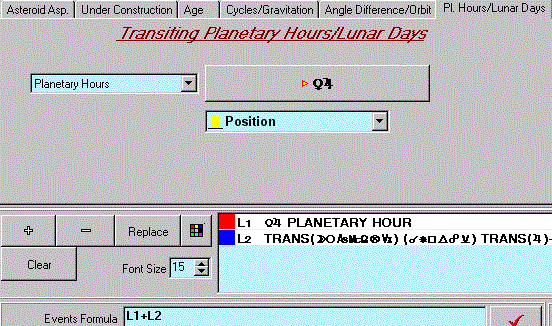
Below is the result of our ULE query. The low of the day occurred during Venus hour, the high during Jupiter hour. Almost every aspect correlated to an effect in the market.
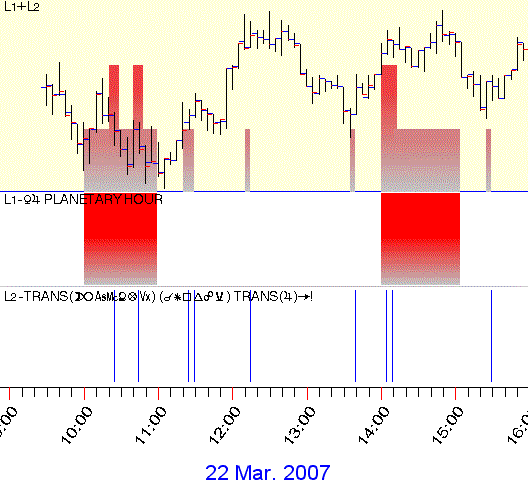
Below are the results of the query in TS's main window. I've added the Smooth Momentum indicator. The idea of course is to trade any SM trendline breaks that occur at about the same time (usually just after, not before ) as a planetary hour or aspect event.
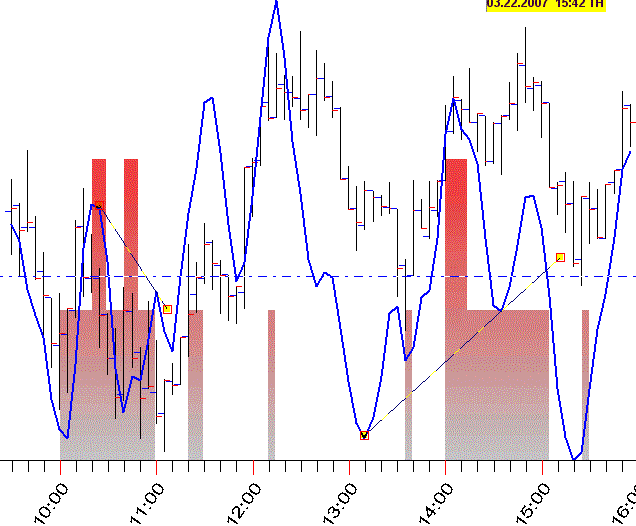
To summarize, there is tremendous value in using triggers to help reduce losing trades. The trigger presented here, Smooth Momentum Trendlines, is an excellent candidate. A trigger should be used as the last step in a trade setup, where the initial parts of the setup give us an opinion about the market. In TS that opinion could be formed from Planetary Line/Divergence, Price Forecasts, Moon Stepping technique (as shown in this article), the 128 technique, and Planetary Hours/Aspects.
Yuri Shramenko
yurips@verizon.net
www.TechEdgeTrading.com
